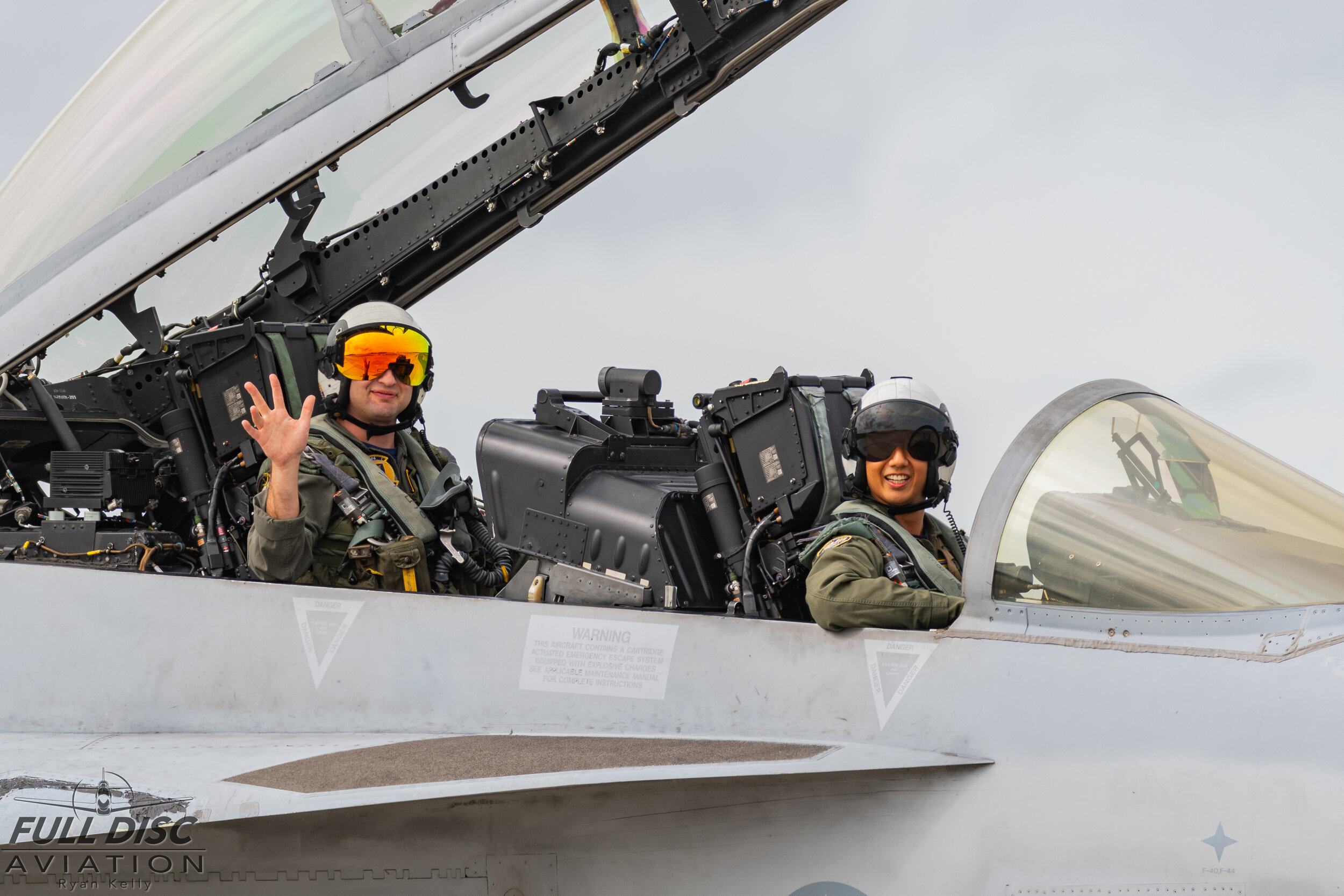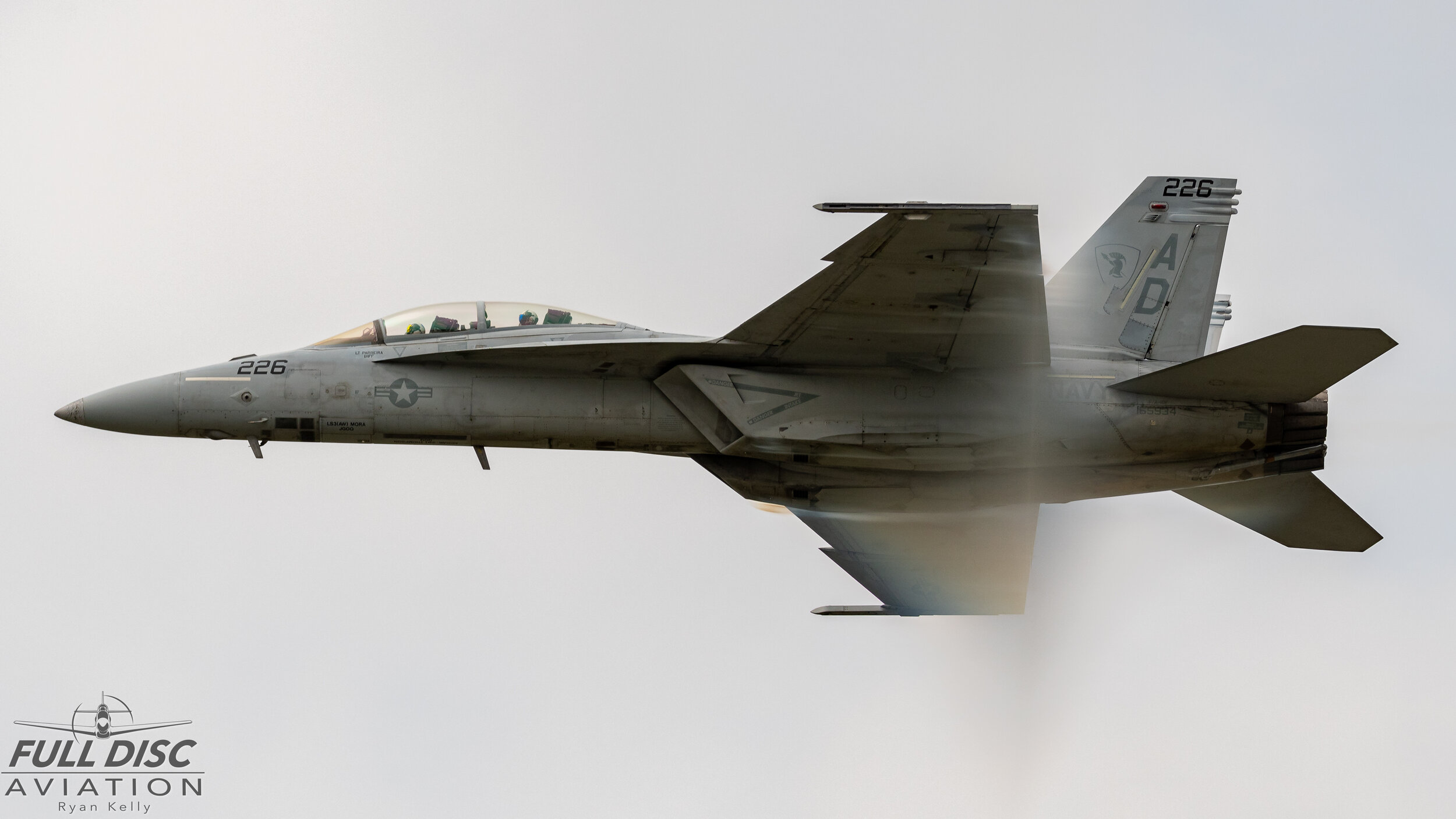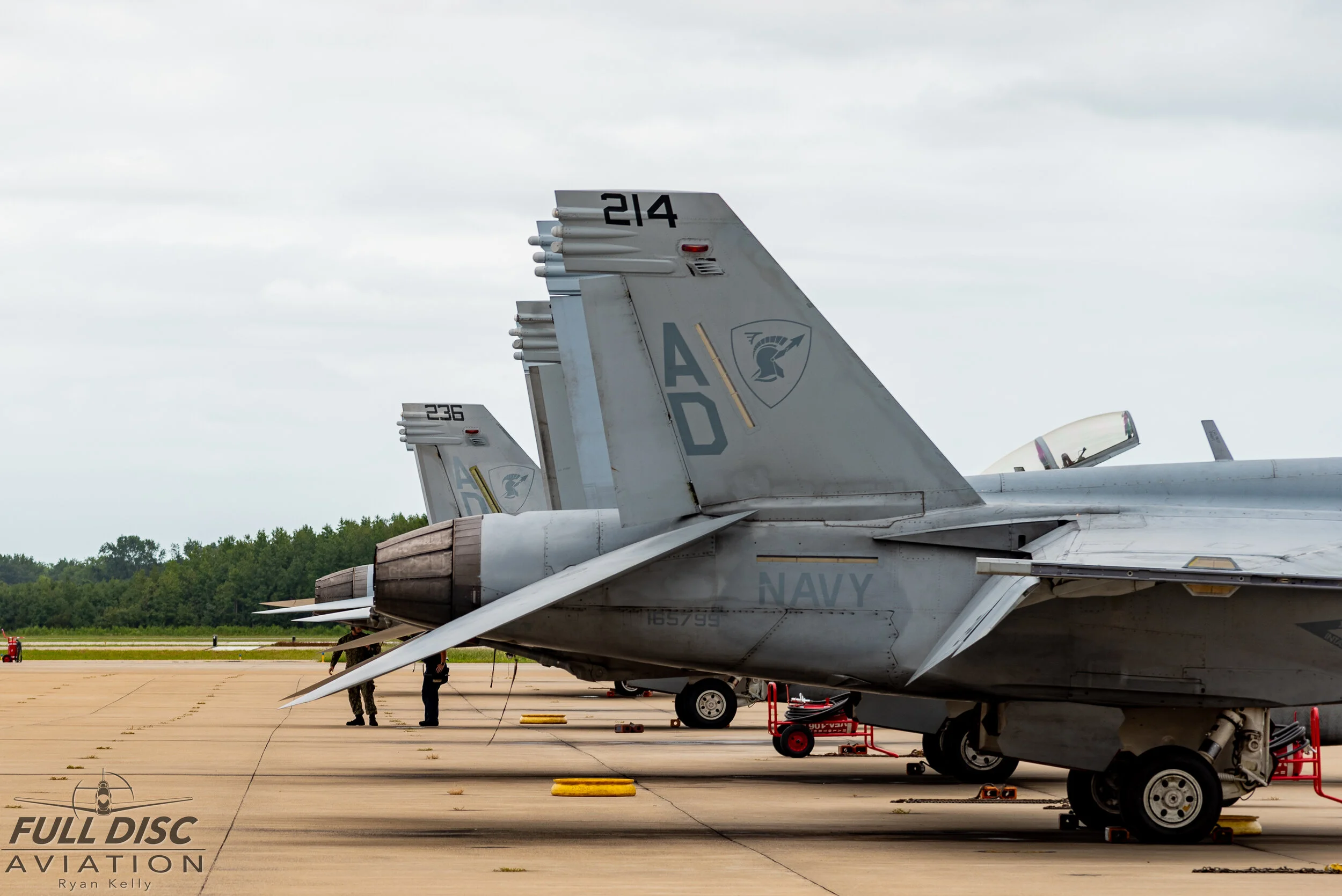VFA-106 Rhino Demo Team
Prose: Nicholas Pascarella
Photography: Ryan Kelly, Nicholas Pascarella, James Woodard, Ryan Tykosh
The hour hand had barely swung past midnight before we were up and moving, on the road with bleary eyes as everyone else was finishing off their evening. After many miles and hours on dark highways, the sun rose softly, a pale orange ball climbing through the persistent haze of wildfire smoke from the west coast, casting an eerie shadow over our destination: Virginia Beach.
We stepped out from our breakfast into the cool morning, and as if on cue, the stillness was shattered by the fabric-ripping sound of afterburners from a two-ship of Rhinos (F/A-18 Super Hornets) rising out of Oceana NAS, home of VFA-106 and the Rhino Demo Team. What better way to welcome us to the east coast's only master jet base?
We linked up with Matt "Syndrome" Lindeman, WSO for the Rhino Demo Team, who generously escorted us on base, into an open briefing room in the VFA-106 hangar, and sat down with us to answer a few questions. We also had the honor and privilege of chatting with his pilot, Kieren "Zero" Sexton, and the other pair of aviators in the Rhino Demo Team; pilot Steve "Scooby" Yoo, and WSO Luke "Oslo" Delisio.
Syndrome was relaxed and soft-spoken, but his eyes conveyed a keen sense of awareness. On his right shoulder flashed the bright red of a FAC(A) patch worn by Forward Air Controllers, masters of coordinating attacks from above.
"I didn't really know anything else," he explains, "my dad was an S-3 Viking pilot, so I basically grew up in the Naval aviation community in the Jacksonville area, that's what spurred my interest in going into aviation. Once he got out of the Navy, he started flying for UPS, so I've really been in aviation my whole life. I attended the Naval academy and when I graduated in 2012 I was selected to serve as a Naval flight officer."
After initial Super Hornet training at VFA-122 in Lemoore, CA, his follow on assignment was VFA-32 and a deployment in support of Operation Inherent Resolve, and finally a move to VFA-106 as a Weapons System instructor. "I wanted to train and teach the next generation of Naval aviation air crew. Thankfully, I got my first choice and got orders here."
Unlike many of the USAF Demonstration Teams which have a dedicated focus, the Rhino Demo Team is only one piece of the puzzle for Syndrome and the others, as their primary responsibility is that of the fleet replacement squadron, or training new aircrews to replace the outgoing ones. "We're trying to schedule a full year next year," he said, in response to a question about the lack of shows this year, "we've dealt with issues before, and the first thing to go is the Demo piece, because ultimately our number one goal as far as personnel, manning, resources, funding, is all going to producing replacement air crew to go to the fleet. Hopefully we get to have a full Demo season [next year] to show the power of the Super Hornet; we're trying to be optimistic."
He escorted us into the VFA-106 ready room, chock full of incredible artifacts from the squadron's storied history. Photographs, paintings, signed footballs, an AIM-9X hanging among the lights on the ceiling; and as we departed for the flightline, murals even adorned the hallway walls adjacent to the hangar. The stairwell walls were covered ceiling to floor with red silhouettes of downed enemy aircraft with the date and pilot/WSO's names stenciled in each kill.
Out on the ramp, the Hornet's Nest buzzed with activity. Supers taxing in all directions, Supers in the overhead, Supers in full burner working bolters on the runways. An E-2 Hawkeye hit the pattern hard a few times, a C-130 lifted off, even a few legacy Hornets, flying with VFC-12, blessed us with their legendary howl, lifting off to go fight students high over the Atlantic.
This puts the uniqueness of the Demo in perspective. "Normally our missions are a lot higher than [the Demo], there's not a lot of times that we are yanking and banking the aircraft down at 200 feet," Syndrome commented. "We push it to the limit on all of our flights...it's pretty insane."
He escorted us back inside and upstairs to meet the rest of the team and chat with them about their journeys. Each of them was as kind and appreciative as the last, eager to chat about this all-consuming passion. Kieran Sexton, callsign "Zero", sat down across from us as we promised not to be too painful.
In this era of Covid, especially inside, masks often remove the view of half of one's face to read personality and facial cues, and the eyes are what's left to convey the full emotion behind the words being spoken, and as expected, Zero's eyes conveyed a sharp awareness, even if his demeanor was relaxed and personable. These aviators see things at 700mph when the rest of us are lucky to see things at 70.
"I was born and raised in Charlotte, North Carolina, [went to the] Naval Academy...I've been in VA Beach since about mid 2014, prior to 106 I was in VFA-131 in the hangar next door, I was a legacy [Hornet] guy over there. Ultimately, I always knew I wanted to be a jet pilot of some sort, my grandfather was an Air Force pilot, flew F-100s and F-4s back in the day."
It's well documented that when 'in the zone' or hyper focused and present, one often forgets what happened afterwards. Conscious thought is released in favor of training and hard-wired 'lizard brain' reaction to wholly invest oneself to the successful completion of a fast-paced, detail-oriented task or situation; for instance, a fighter jet demonstration, or even a first flight. When asked about his first Super Hornet ride, "I would say it's complete blackout at this point," Zero laughed. "It's just pretty exhilarating," he went on, "you're like, 'this is awesome' and then it's all over."
We spoke with the other team, Scooby and Oslo, before heading down the hallway to the briefing room, where Zero briefed everyone on the low Demo. Quickly and concisely, he walked through each facet of the upcoming flight, maneuvering the Super Hornet-on-a-stick as he described each change in orientation, pausing only to note that if a C-130 needed to takeoff during the routine, they would just have to wait patiently.
Walking the halls to the flightline, Steve Yoo, callsign "Scooby", towered over many of the other aviators. "I'm six-[foot]-two, about the max of what's comfortable [in the Rhino]," he said. "I've always been fascinated by aviation," he had told us earlier, "Growing up, I'd have toy airplane models that I'd fly around with...I'd sit in my living room and pretend that I was flying a fighter jet on my lazy boy recliner. I just wanted to be a Navy fighter pilot, fly F-18s off of aircraft carriers, so getting to do this is truly a dream come true."
We parted with the aviators and reconvened at the jet with our respective gear for preflight. The previous F-18 Demo pilot, Chris "Chinütz" Walker, along with Amanda "Stalin" Lee and Karl "Krampus" Knight kindly escorted us to the runway for back to back Rhino Demos; Zero and Syndrome first, and Scooby and Oslo followed. With our backs to the safety ops truck, with Chinütz, Krampus, and Stalin, as safety observers, we were privy to the awesome power and might of the Super Hornet.
One after the other, the teams executed the routine with crisp accuracy and drama, thundering overhead time and time again. The west coast wildfire haze negated the possibility of a high show, so each maneuver stayed low and fast, except for the high-alpha, tailhook and bolter pass of course, the former being a rather surprising favorite for Scooby.
"I remember watching the F-18 Demo prior to joining the service and I still feel the same way...my favorite maneuver [is] the high alpha pass," he reflected. "I just think it's so cool seeing a jet being able to fly that slow and just have their nose all the way up in the air, cruising down the show line. That was impressive for me as a spectator and being able to fly it here, it's a lot of fun."
Zero had a different favorite; "...probably the inverted whisper pass, just because we don't really go upside down at any point throughout our career outside of the Demo itself, especially for 10 seconds. It doesn't really seem like a long time, but it's a relatively long time [when] you're not really used to it." Luke "Oslo" Delisio was with Scooby: "I think the high alpha pass is pretty cool. Just kind of hanging out on the blades."
Oslo would know; "My dad worked [for GE] on the engines." Oslo spent time around the squadrons growing up in Massachusetts before going to Purdue through a program that "basically brought me to the Navy OCS." After a fleet tour with the Gypsies, VFA-106 became his new home. We asked him about the most rewarding thing for him, being on the Rhino Demo Team; "I think it's just giving back. I used to be that kid at the airshow that was such a geek. Now I can actually give back and speak to those kids whenever we get the opportunity to do that again."
His eyes revealed a deep smile as he continued, "I'm super, super excited to show it off and [demonstrate] the capabilities of the airplane, as well as inspire the next generation to step in when we step out. My grandfather was a C-47 pilot in the Army Air Corps, that inspired my dad to get into aviation, who ended up becoming an engineer at GE Aviation, who built aircraft engines at the time...he'd visit squadrons and bring all the cool videos back, and that made me want to go fly F-18s for the Navy specifically," he concluded. "It all worked out," he mused.
Indeed it did, and all four of the Rhino Demo Team aviators routinely tear apart the airspace over NAS Oceana as the disjointed 2020 season rolls along. "Been an interesting year," Oslo noted, drawing laughter from everyone. Pandemic or not, the morale at VFA-106 is strong and the atmosphere instills supreme confidence that the next generation of Super Hornet drivers is learning from the very best.
Keep your eyes keen for the Rhino Demo Team on social media, and rest assured if they're not as socially visible as some other teams, just remember they're still hard at work, passing on invaluable information and training upcoming Rhino pilots and WSOs so they can survive an ever-changing combat environment after the Instructors have moved on. The sacred art of instruction rolls along like the wheels of a Rhino, and VFA-106 is up to the task.
Special thanks to Commander Dan Catlin, VFA-106 officers, staff and maintenance, Krampus, Stalin, Chinütz, Oslo, Scooby, Zero, and Syndrome.

























































































































































